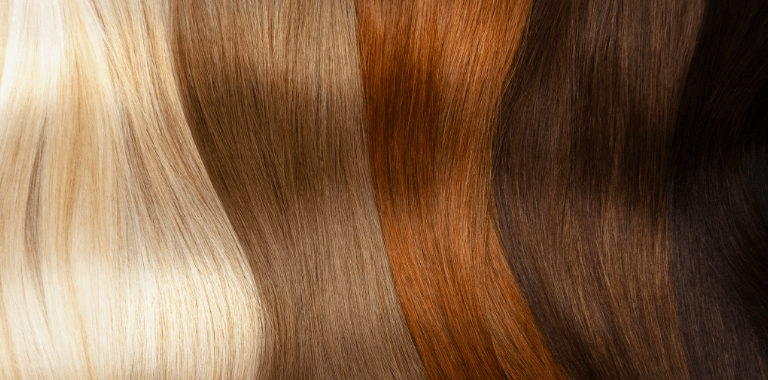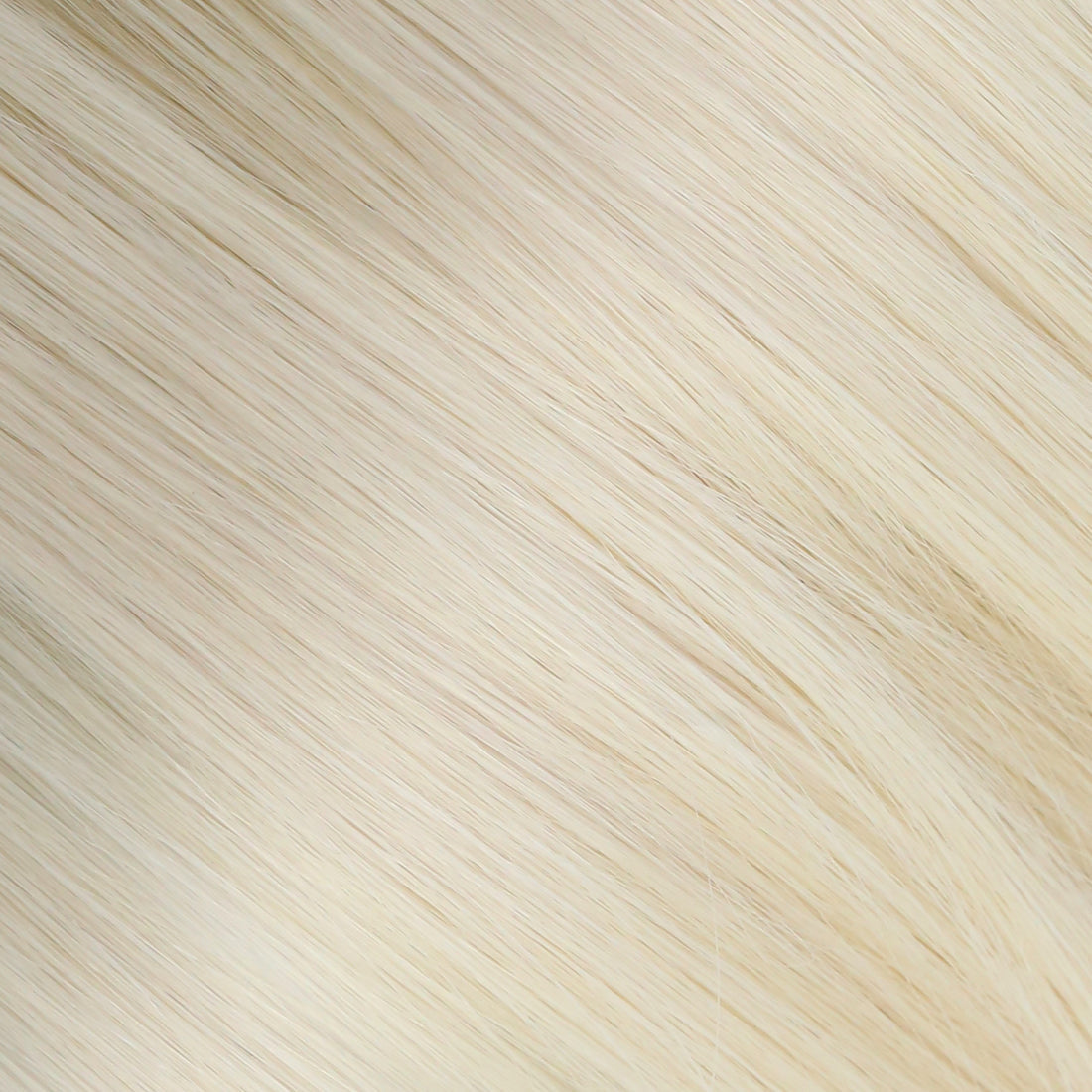Hair extensions have surged in popularity as a transformative beauty solution, offering instant length, volume, and even color without the commitment of permanent changes. With all types of hair extensions out there, selecting the right type of hair extension is crucial for achieving the desired look, ensuring compatibility with one's natural hair, and maintaining hair health. This blog aims to demystify the various hair extension types, guiding you through these choices to make an informed decision tailored to your personal style and needs. Let’s dive in!
What are the most popular types of hair extensions?
Navigating the world of hair extensions can be overwhelming with so many types to choose from. Each offers unique benefits and considerations. Let’s dive into the most popular types of hair extensions, helping you understand their distinctions and find your perfect match.
1. Clip-in hair extensions
Clip-in hair extensions provide a simple and temporary method for augmenting the volume and length of your hair. These extensions stand out for their ease of use, allowing for quick application and removal without the need for a salon visit. This makes them an ideal choice for individuals seeking to alter their appearance for special events or in their everyday life. Let’s delve deeper into why clip-in hair extensions are a popular option for many.
What are clip-ins and how do they work?
Clip-in hair extensions consist of strands of hair attached to small clips. These clips can be snapped open and closed, allowing you to attach the extensions to your natural hair. The process is simple:
- Section your natural hair.
- Open the clip and attach it near the roots of your sectioned hair.
- Release your natural hair to blend with the extensions.

Pros and cons of clip-ins
Pros:
- Easy to use: Can be applied and removed at home without professional assistance.
- Non-damaging: Unlike permanent extensions, clip-ins don’t put continuous pressure on your roots, reducing the risk of damage.
- Versatile: Allows for temporary changes in length, volume, and even color.
Cons:
- Temporary: Need to be removed before sleeping or swimming.
- Visible if not well placed: Clips may be noticeable if not properly secured or hidden.
- Can feel heavy: May cause discomfort if worn for extended periods.
Who are clip-ins best suited for?
Clip-in hair extensions are ideal for those seeking a non-committal way to experiment with their hairstyle. They’re perfect for special events, photo shoots, or just adding a bit of flair to your everyday look. If you desire versatility without the long-term commitment or risk of damage to your natural hair, clip-ins are your best bet.
2. Tape-in hair extensions
Tape-in hair extensions are a popular semi-permanent hair enhancement method, favored for their natural appearance and durability. They involve thin, pre-taped wefts that are taped between layers of your natural hair, close to the roots. This method offers a more permanent solution than clip-ins, providing volume and length for weeks at a time. Here’s a detailed look at tape-in extensions and what you need to know about them.

How are tape-ins applied?
Tape-in extensions consist of 1 to 2-inch wide wefts of hair with a strip of special adhesive tape on one side. The application process involves:
- Parting a small section of your hair.
- Peeling off the backing on the tape to reveal the adhesive.
- Pressing the tape against the root of your sectioned hair and securing it by pressing another weft on the opposite side, sandwiching your natural hair in between.
Pros and cons of tape-ins
Pros:
- Natural-looking: Sits flat against the head, offering a seamless blend with your natural hair.
- Lightweight: Less likely to feel heavy or uncomfortable.
- Long-lasting: Can be worn for 4-8 weeks before needing reapplication.
Cons:
- Maintenance: Requires careful maintenance to prevent tangling and matting.
- Potential for damage: Incorrect application or removal can lead to hair damage.
- Limited styling: Heat and certain hair products can weaken the adhesive, limiting styling options.
Essential maintenance tips for clip-ins
- Avoid oily products near the roots to prevent the tape from slipping.
- Brush gently to avoid tugging at the tape.
- Use a sulfate-free shampoo and avoid conditioning the roots to maintain the adhesive’s integrity.
- Schedule regular salon visits for maintenance and reapplication to keep your extensions looking their best.
Tape-in extensions are an excellent choice for those looking for a more permanent hair enhancement solution that offers a natural look and feel. With proper care and maintenance, they can provide a hassle-free, beautiful addition to your natural hair.
3. Sew-in hair extensions
Sew-in or weave hair extensions are a durable, semi-permanent method that involves braiding the natural hair into cornrows and then sewing the extension wefts onto the braids with a needle and thread. This technique is highly favored for its durability and the seamless blend it offers with natural hair textures, particularly those of a thicker, coarser nature. Below, we explore the intricacies of sew-in extensions, their advantages, and considerations, as well as who might be the best candidate for this type of hair enhancement.

Understanding the sew-in process
The application of sew-in hair extensions begins with the natural hair being braided into a series of cornrows across the scalp. The wefts of the hair extensions are then sewn directly onto these braids using a special needle and thread. The process can take several hours to complete but results in a secure and natural-looking enhancement.
Pros and cons of sew-in hair extensions
Pros:
- Long-lasting: With proper care, sew-ins can last for 6-8 weeks.
- Protective style: Offers a break for your natural hair from styling and environmental damage.
- Versatility: Allows for a wide range of styles, including updos and ponytails.
Cons:
- Tension: Can cause tension on the scalp, leading to discomfort or hair loss if too tight.
- Maintenance: Requires regular care and maintenance to keep the scalp healthy.
- Time-consuming: The application and removal process is lengthy.
Who are sew-in extensions best suited for?
Among those popular types of hair extensions, sew-in extensions are particularly suited for those with thicker, coarser hair types due to the need for the natural hair to securely hold the cornrows. They are ideal for individuals looking for a protective style that promotes hair growth by minimizing daily manipulation. Moreover, those committed to routine maintenance and care of their extensions will find sew-ins a rewarding option for long-term use.
4. Micro-link hair extensions
Micro-link, also termed micro-bead or i-tip extensions, stand out as a favored approach for length and volume enhancement without the need for glue or sewing. This method utilizes small, bead-like attachments that are secured to tiny portions of the user's own hair, ensuring flawless and sturdy integration. We will examine the intricacies of micro-link extensions, focusing on their installation technique, advantages, disadvantages, and tips for optimal upkeep.

How are micro-links applied?
The application process involves threading a small section of natural hair through a micro-bead, then inserting the hair extension into the bead alongside the natural hair. The bead is then clamped down with a special tool to secure the extension in place. This method allows for adjustments and repositioning as needed, providing a customizable and flexible hair enhancement solution.
Pros and cons of micro-links
Pros:
- No heat or glue required: Reduces the risk of damage to natural hair.
- Adjustable: Beads can be loosened or tightened as needed.
- Natural-looking: Extensions can be placed strategically for a seamless blend.
Cons:
- Potential for damage: Incorrect application or tension can stress natural hair.
- Maintenance: Micro-links require regular checks to ensure beads are not slipping.
- Visibility: Beads might be visible if not matched correctly with hair color or if hair is very thin.
How to take care of micro-links
- Brush gently: Use a soft-bristle brush to avoid pulling at the beads.
- Avoid oily products at the root: This can cause beads to slip.
- Regular salon visits: Professionals can adjust the tightness and position of beads to prevent damage.
Micro-link extensions are ideal for those seeking a less invasive, glue-free option for hair enhancement, offering both longevity and a natural look when properly maintained.
5. Fusion hair extensions
Fusion hair extensions, or k-tip extensions, utilize a keratin bonding process to merge extensions seamlessly with natural hair, offering a durable and natural-looking enhancement. This method is favored for its long-lasting results and ability to blend effortlessly with the wearer's natural hair. Below, we explore the unique aspects of fusion extensions, including the application process, benefits, drawbacks, and care tips to ensure their longevity.

How are k-tip extensions applied?
K-tip extensions are attached by melting a special glue on them and sticking them to your own hair with a hot tool. This makes sure they stick really well and look just like your hair, moving with it and not being noticeable. It's a way to make your hair longer or fuller that feels comfortable and lasts a long time.
Pros and cons of k-tips
Pros:
- Durability: Lasts up to 6 months with proper care.
- Natural Movement: Bonds allow hair to move freely.
- Invisible Bonds: Keratin bonds are small and match the hair color, making them virtually undetectable.
Cons:
- Application Time: The process can be lengthy.
- Potential Damage: Heat application can risk hair damage if not done correctly.
- Removal: Requires professional removal to prevent hair damage.
Care and maintenance tips for k-tips
- Gentle Brushing: Use a soft brush and avoid tugging at the bonds.
- Avoid Oil-Based Products Near Bonds: Prevents the keratin from breaking down.
- Regular Salon Visits: For check-ups, adjustments, and professional advice on upkeep.
Fusion hair extensions offer a high-quality, natural-looking option for those seeking a semi-permanent solution to hair enhancement, combining the benefits of durability and a seamless blend with natural hair when properly maintained.
What to consider when choosing hair extensions
Choosing the right ones from all the fascinating types of hair extensions involves several key considerations to ensure they perfectly match your needs and lifestyle:
• Hair Type and Texture Compatibility
Match the extensions to your natural hair texture for a seamless blend.
Consider whether the extensions can be styled in harmony with your natural hair.
• Desired Length and Volume
Determine how much length and volume you want to achieve your ideal appearance.
Assess the weight of extensions to avoid strain on your natural hair.
• Lifestyle and Maintenance Commitment
Evaluate how much time you are willing to dedicate to extension care and maintenance.
Consider your daily activities and choose extensions that can withstand your lifestyle.
• Cost and Longevity of the Extensions
Compare initial costs versus ongoing maintenance expenses.
Consider how often the extensions will need to be replaced or maintained.
Balancing these factors will help guide you to the best hair extension choice, ensuring a blend of aesthetic appeal, practicality, and financial sense.
Summing up
Picking the right hair extensions is key to achieving your ideal look and keeping your hair healthy. Talk to a hair extension expert for advice tailored to your hair type and lifestyle. They'll help ensure you get a natural, stylish result that suits you perfectly.












